University Commercial Law Report: Australian Legal Framework Analysis
VerifiedAdded on 2021/05/31
|13
|2875
|33
Report
AI Summary
This report provides an analysis of Australian Commercial Law, focusing on Hart's theory of recognition, contract law principles, and remedies for breach of contract. Part A examines Hart's theory and its application within the Australian legal framework, comparing it to the UK system. Part B addresses a case study involving a contract for the sale of a fruit and vegetable store, exploring issues of misrepresentation, including fraudulent misrepresentation, and its impact on contract validity. The report further delves into remedies available under the Sale of Goods Act for breach of contract, evaluating the supplier's obligations and the buyer's rights. The analysis covers relevant case law and statutory provisions, providing a comprehensive overview of the legal principles involved.
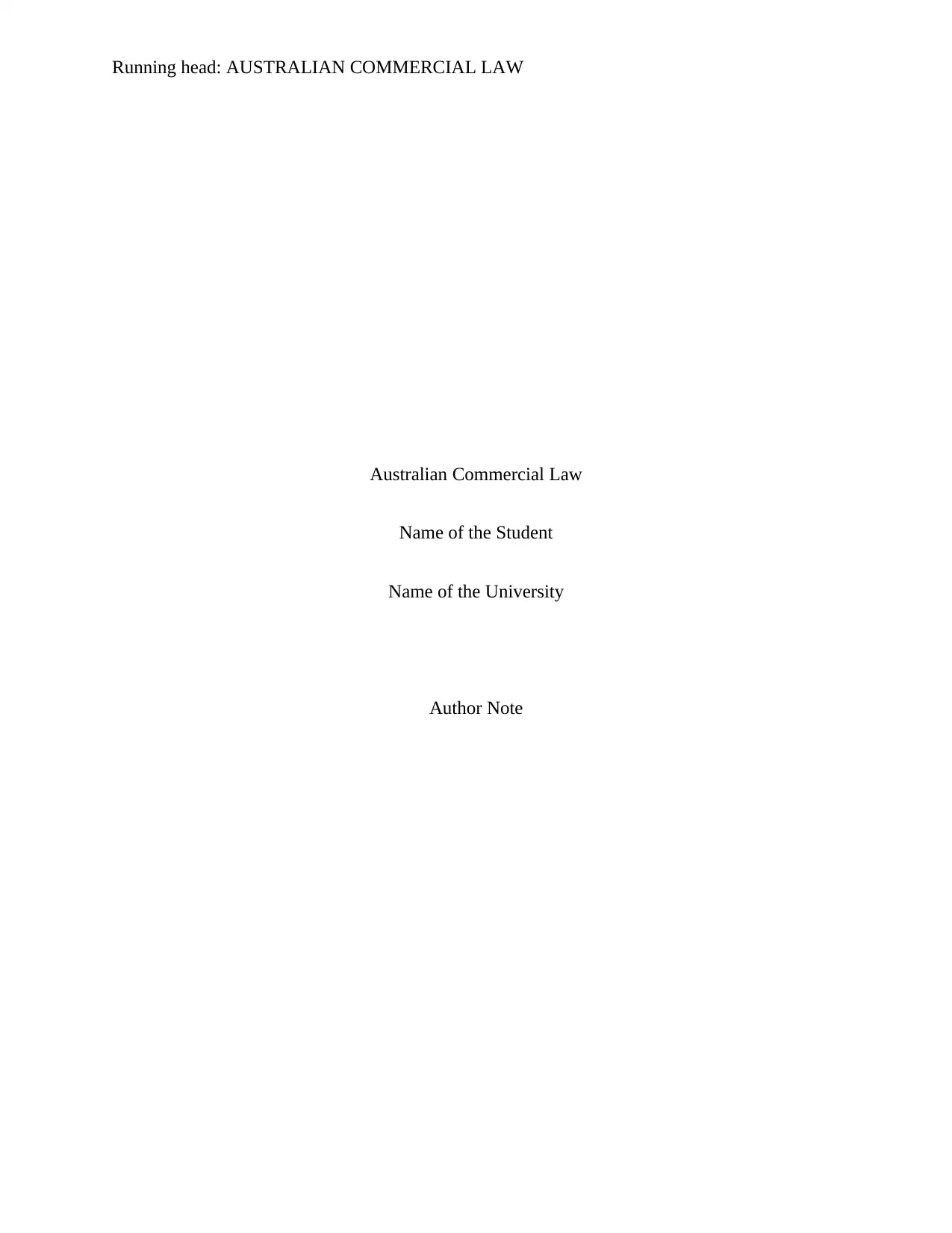
Running head: AUSTRALIAN COMMERCIAL LAW
Australian Commercial Law
Name of the Student
Name of the University
Author Note
Australian Commercial Law
Name of the Student
Name of the University
Author Note
Paraphrase This Document
Need a fresh take? Get an instant paraphrase of this document with our AI Paraphraser
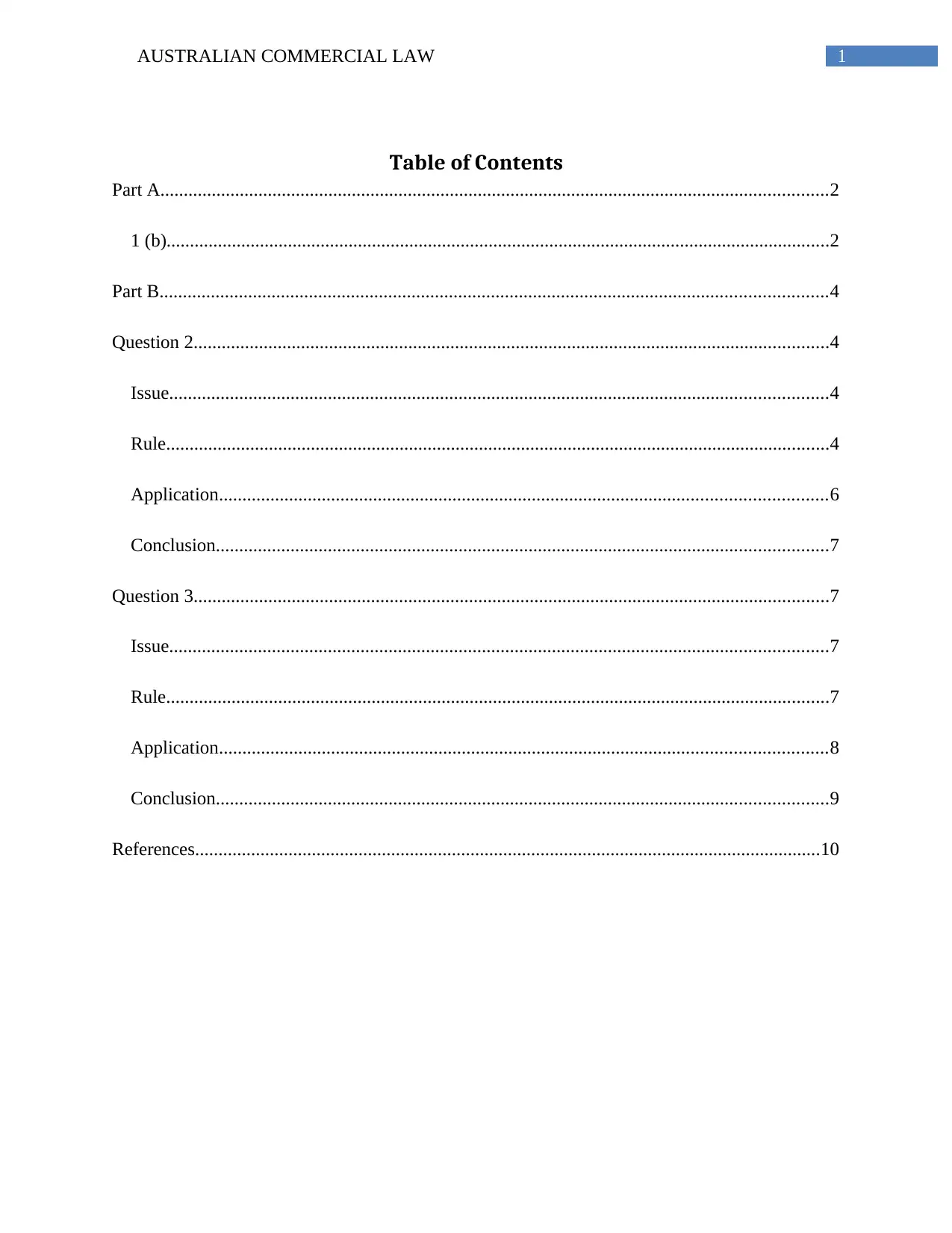
1AUSTRALIAN COMMERCIAL LAW
Table of Contents
Part A...............................................................................................................................................2
1 (b)..............................................................................................................................................2
Part B...............................................................................................................................................4
Question 2........................................................................................................................................4
Issue.............................................................................................................................................4
Rule..............................................................................................................................................4
Application..................................................................................................................................6
Conclusion...................................................................................................................................7
Question 3........................................................................................................................................7
Issue.............................................................................................................................................7
Rule..............................................................................................................................................7
Application..................................................................................................................................8
Conclusion...................................................................................................................................9
References......................................................................................................................................10
Table of Contents
Part A...............................................................................................................................................2
1 (b)..............................................................................................................................................2
Part B...............................................................................................................................................4
Question 2........................................................................................................................................4
Issue.............................................................................................................................................4
Rule..............................................................................................................................................4
Application..................................................................................................................................6
Conclusion...................................................................................................................................7
Question 3........................................................................................................................................7
Issue.............................................................................................................................................7
Rule..............................................................................................................................................7
Application..................................................................................................................................8
Conclusion...................................................................................................................................9
References......................................................................................................................................10
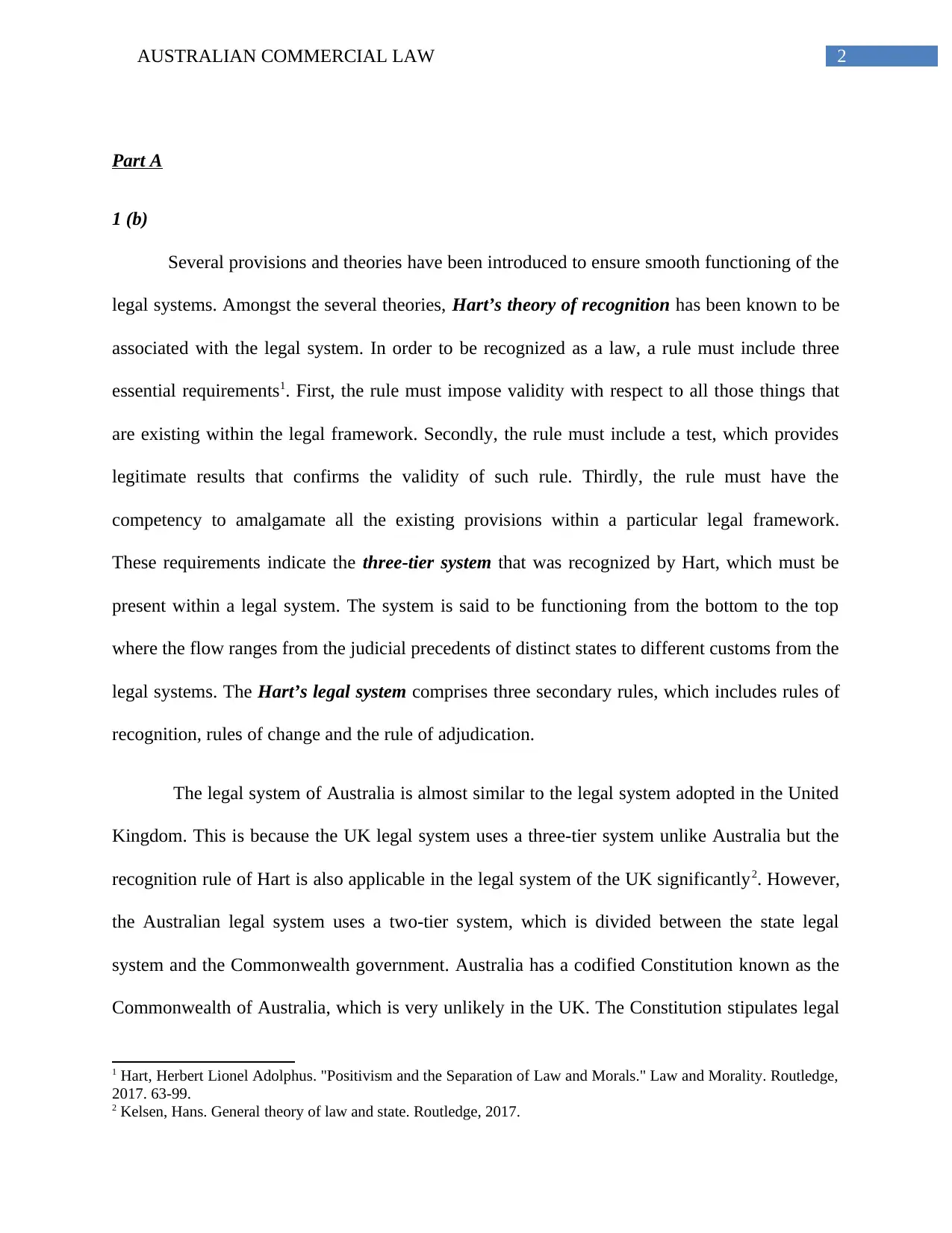
2AUSTRALIAN COMMERCIAL LAW
Part A
1 (b)
Several provisions and theories have been introduced to ensure smooth functioning of the
legal systems. Amongst the several theories, Hart’s theory of recognition has been known to be
associated with the legal system. In order to be recognized as a law, a rule must include three
essential requirements1. First, the rule must impose validity with respect to all those things that
are existing within the legal framework. Secondly, the rule must include a test, which provides
legitimate results that confirms the validity of such rule. Thirdly, the rule must have the
competency to amalgamate all the existing provisions within a particular legal framework.
These requirements indicate the three-tier system that was recognized by Hart, which must be
present within a legal system. The system is said to be functioning from the bottom to the top
where the flow ranges from the judicial precedents of distinct states to different customs from the
legal systems. The Hart’s legal system comprises three secondary rules, which includes rules of
recognition, rules of change and the rule of adjudication.
The legal system of Australia is almost similar to the legal system adopted in the United
Kingdom. This is because the UK legal system uses a three-tier system unlike Australia but the
recognition rule of Hart is also applicable in the legal system of the UK significantly2. However,
the Australian legal system uses a two-tier system, which is divided between the state legal
system and the Commonwealth government. Australia has a codified Constitution known as the
Commonwealth of Australia, which is very unlikely in the UK. The Constitution stipulates legal
1 Hart, Herbert Lionel Adolphus. "Positivism and the Separation of Law and Morals." Law and Morality. Routledge,
2017. 63-99.
2 Kelsen, Hans. General theory of law and state. Routledge, 2017.
Part A
1 (b)
Several provisions and theories have been introduced to ensure smooth functioning of the
legal systems. Amongst the several theories, Hart’s theory of recognition has been known to be
associated with the legal system. In order to be recognized as a law, a rule must include three
essential requirements1. First, the rule must impose validity with respect to all those things that
are existing within the legal framework. Secondly, the rule must include a test, which provides
legitimate results that confirms the validity of such rule. Thirdly, the rule must have the
competency to amalgamate all the existing provisions within a particular legal framework.
These requirements indicate the three-tier system that was recognized by Hart, which must be
present within a legal system. The system is said to be functioning from the bottom to the top
where the flow ranges from the judicial precedents of distinct states to different customs from the
legal systems. The Hart’s legal system comprises three secondary rules, which includes rules of
recognition, rules of change and the rule of adjudication.
The legal system of Australia is almost similar to the legal system adopted in the United
Kingdom. This is because the UK legal system uses a three-tier system unlike Australia but the
recognition rule of Hart is also applicable in the legal system of the UK significantly2. However,
the Australian legal system uses a two-tier system, which is divided between the state legal
system and the Commonwealth government. Australia has a codified Constitution known as the
Commonwealth of Australia, which is very unlikely in the UK. The Constitution stipulates legal
1 Hart, Herbert Lionel Adolphus. "Positivism and the Separation of Law and Morals." Law and Morality. Routledge,
2017. 63-99.
2 Kelsen, Hans. General theory of law and state. Routledge, 2017.
⊘ This is a preview!⊘
Do you want full access?
Subscribe today to unlock all pages.

Trusted by 1+ million students worldwide
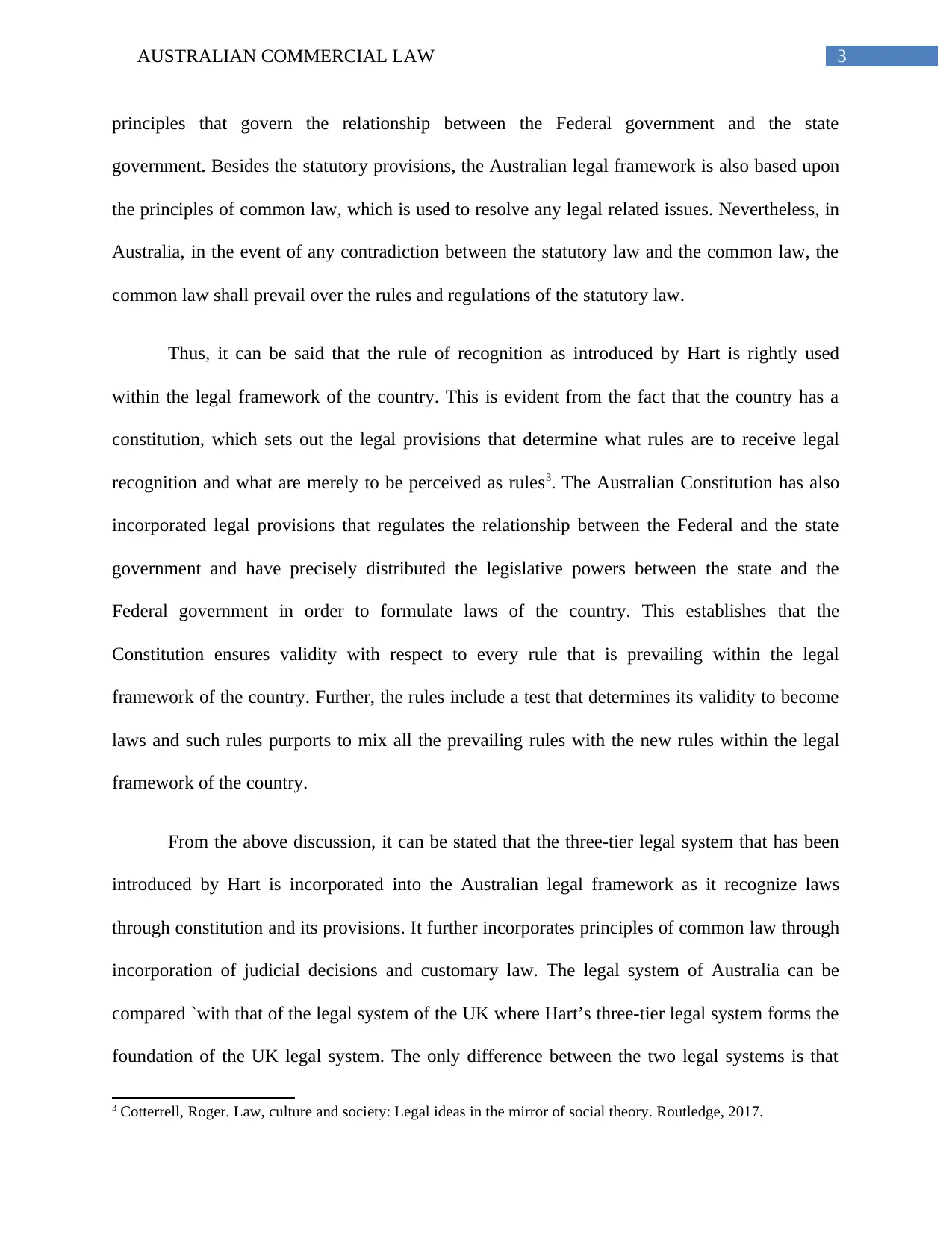
3AUSTRALIAN COMMERCIAL LAW
principles that govern the relationship between the Federal government and the state
government. Besides the statutory provisions, the Australian legal framework is also based upon
the principles of common law, which is used to resolve any legal related issues. Nevertheless, in
Australia, in the event of any contradiction between the statutory law and the common law, the
common law shall prevail over the rules and regulations of the statutory law.
Thus, it can be said that the rule of recognition as introduced by Hart is rightly used
within the legal framework of the country. This is evident from the fact that the country has a
constitution, which sets out the legal provisions that determine what rules are to receive legal
recognition and what are merely to be perceived as rules3. The Australian Constitution has also
incorporated legal provisions that regulates the relationship between the Federal and the state
government and have precisely distributed the legislative powers between the state and the
Federal government in order to formulate laws of the country. This establishes that the
Constitution ensures validity with respect to every rule that is prevailing within the legal
framework of the country. Further, the rules include a test that determines its validity to become
laws and such rules purports to mix all the prevailing rules with the new rules within the legal
framework of the country.
From the above discussion, it can be stated that the three-tier legal system that has been
introduced by Hart is incorporated into the Australian legal framework as it recognize laws
through constitution and its provisions. It further incorporates principles of common law through
incorporation of judicial decisions and customary law. The legal system of Australia can be
compared `with that of the legal system of the UK where Hart’s three-tier legal system forms the
foundation of the UK legal system. The only difference between the two legal systems is that
3 Cotterrell, Roger. Law, culture and society: Legal ideas in the mirror of social theory. Routledge, 2017.
principles that govern the relationship between the Federal government and the state
government. Besides the statutory provisions, the Australian legal framework is also based upon
the principles of common law, which is used to resolve any legal related issues. Nevertheless, in
Australia, in the event of any contradiction between the statutory law and the common law, the
common law shall prevail over the rules and regulations of the statutory law.
Thus, it can be said that the rule of recognition as introduced by Hart is rightly used
within the legal framework of the country. This is evident from the fact that the country has a
constitution, which sets out the legal provisions that determine what rules are to receive legal
recognition and what are merely to be perceived as rules3. The Australian Constitution has also
incorporated legal provisions that regulates the relationship between the Federal and the state
government and have precisely distributed the legislative powers between the state and the
Federal government in order to formulate laws of the country. This establishes that the
Constitution ensures validity with respect to every rule that is prevailing within the legal
framework of the country. Further, the rules include a test that determines its validity to become
laws and such rules purports to mix all the prevailing rules with the new rules within the legal
framework of the country.
From the above discussion, it can be stated that the three-tier legal system that has been
introduced by Hart is incorporated into the Australian legal framework as it recognize laws
through constitution and its provisions. It further incorporates principles of common law through
incorporation of judicial decisions and customary law. The legal system of Australia can be
compared `with that of the legal system of the UK where Hart’s three-tier legal system forms the
foundation of the UK legal system. The only difference between the two legal systems is that
3 Cotterrell, Roger. Law, culture and society: Legal ideas in the mirror of social theory. Routledge, 2017.
Paraphrase This Document
Need a fresh take? Get an instant paraphrase of this document with our AI Paraphraser
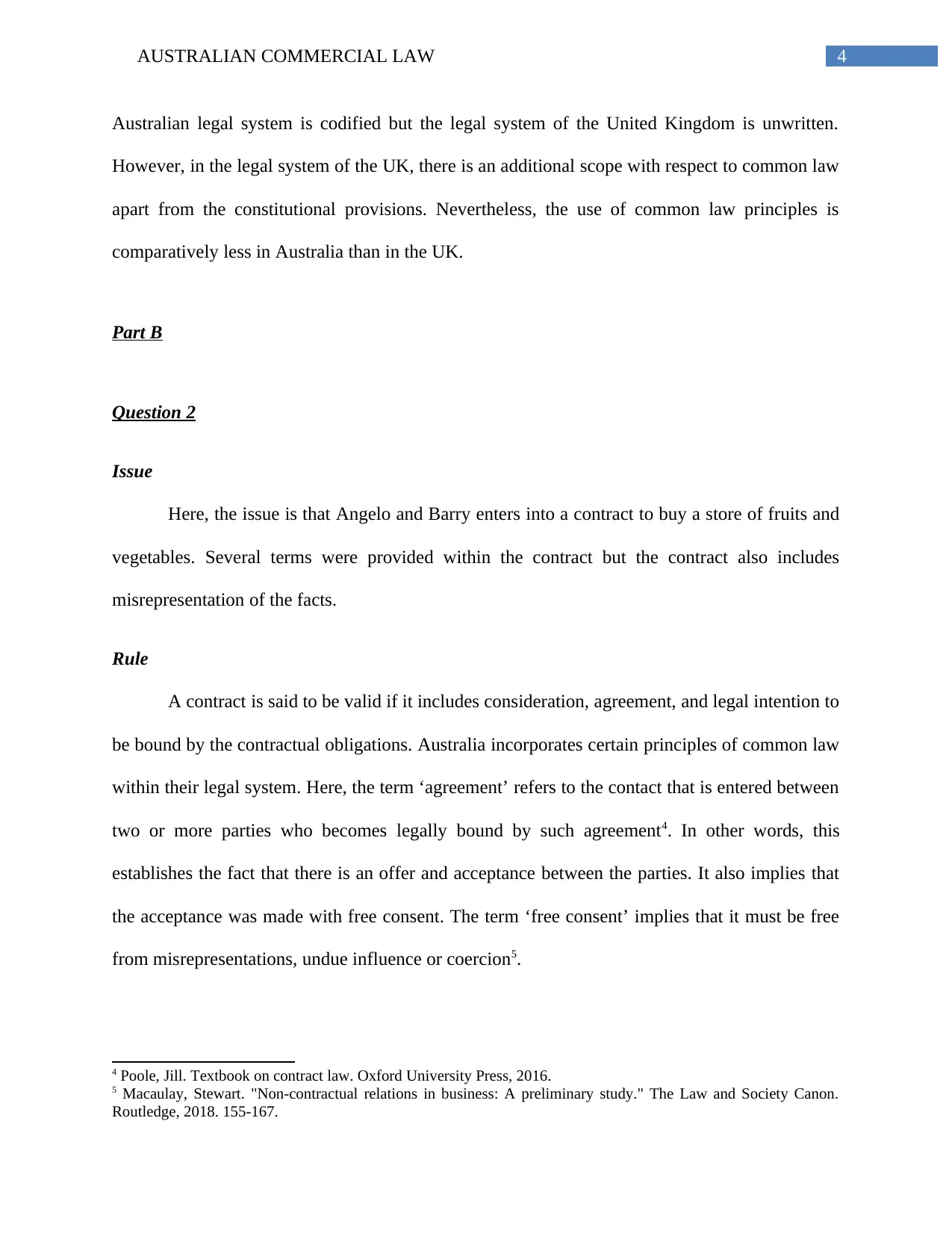
4AUSTRALIAN COMMERCIAL LAW
Australian legal system is codified but the legal system of the United Kingdom is unwritten.
However, in the legal system of the UK, there is an additional scope with respect to common law
apart from the constitutional provisions. Nevertheless, the use of common law principles is
comparatively less in Australia than in the UK.
Part B
Question 2
Issue
Here, the issue is that Angelo and Barry enters into a contract to buy a store of fruits and
vegetables. Several terms were provided within the contract but the contract also includes
misrepresentation of the facts.
Rule
A contract is said to be valid if it includes consideration, agreement, and legal intention to
be bound by the contractual obligations. Australia incorporates certain principles of common law
within their legal system. Here, the term ‘agreement’ refers to the contact that is entered between
two or more parties who becomes legally bound by such agreement4. In other words, this
establishes the fact that there is an offer and acceptance between the parties. It also implies that
the acceptance was made with free consent. The term ‘free consent’ implies that it must be free
from misrepresentations, undue influence or coercion5.
4 Poole, Jill. Textbook on contract law. Oxford University Press, 2016.
5 Macaulay, Stewart. "Non-contractual relations in business: A preliminary study." The Law and Society Canon.
Routledge, 2018. 155-167.
Australian legal system is codified but the legal system of the United Kingdom is unwritten.
However, in the legal system of the UK, there is an additional scope with respect to common law
apart from the constitutional provisions. Nevertheless, the use of common law principles is
comparatively less in Australia than in the UK.
Part B
Question 2
Issue
Here, the issue is that Angelo and Barry enters into a contract to buy a store of fruits and
vegetables. Several terms were provided within the contract but the contract also includes
misrepresentation of the facts.
Rule
A contract is said to be valid if it includes consideration, agreement, and legal intention to
be bound by the contractual obligations. Australia incorporates certain principles of common law
within their legal system. Here, the term ‘agreement’ refers to the contact that is entered between
two or more parties who becomes legally bound by such agreement4. In other words, this
establishes the fact that there is an offer and acceptance between the parties. It also implies that
the acceptance was made with free consent. The term ‘free consent’ implies that it must be free
from misrepresentations, undue influence or coercion5.
4 Poole, Jill. Textbook on contract law. Oxford University Press, 2016.
5 Macaulay, Stewart. "Non-contractual relations in business: A preliminary study." The Law and Society Canon.
Routledge, 2018. 155-167.
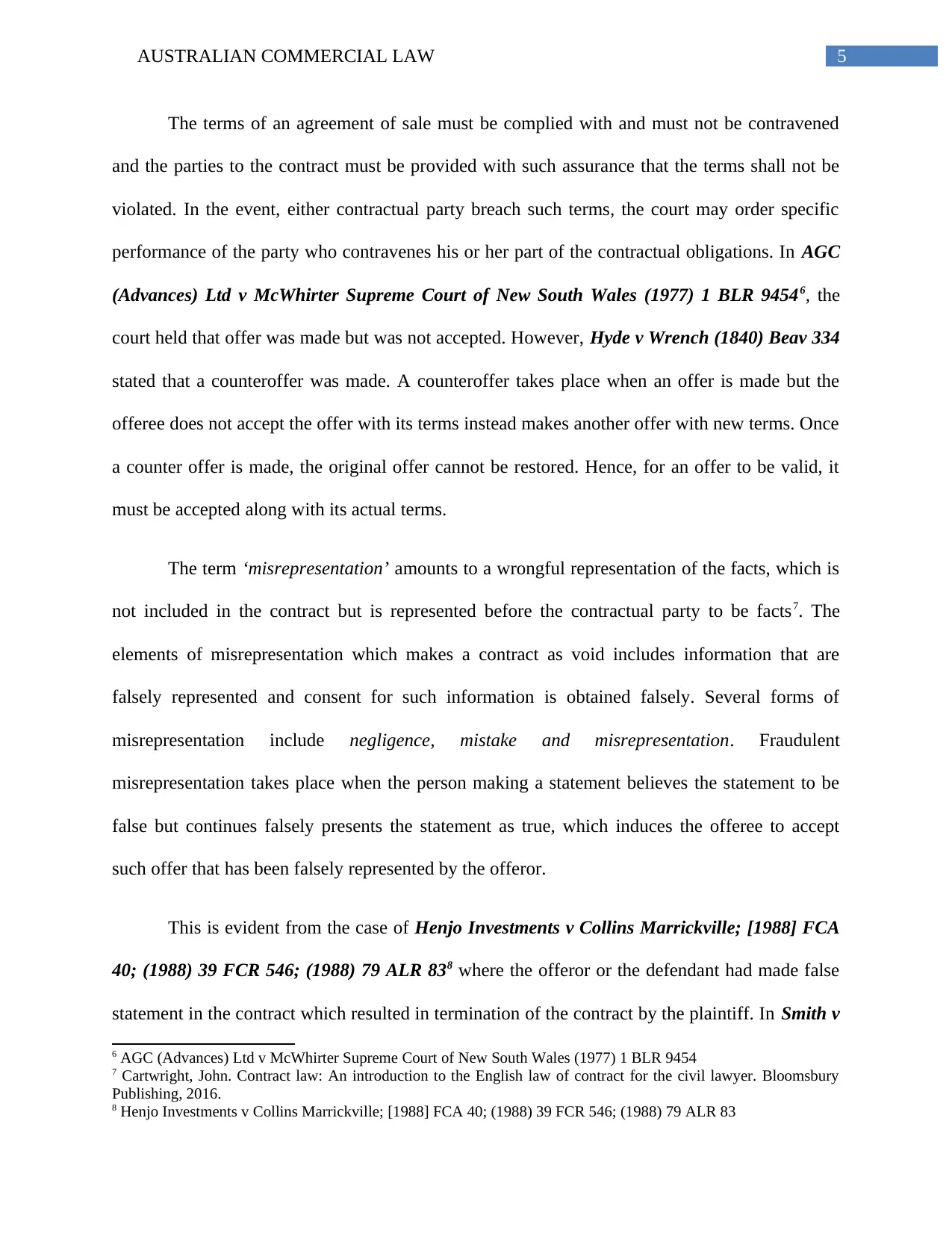
5AUSTRALIAN COMMERCIAL LAW
The terms of an agreement of sale must be complied with and must not be contravened
and the parties to the contract must be provided with such assurance that the terms shall not be
violated. In the event, either contractual party breach such terms, the court may order specific
performance of the party who contravenes his or her part of the contractual obligations. In AGC
(Advances) Ltd v McWhirter Supreme Court of New South Wales (1977) 1 BLR 94546, the
court held that offer was made but was not accepted. However, Hyde v Wrench (1840) Beav 334
stated that a counteroffer was made. A counteroffer takes place when an offer is made but the
offeree does not accept the offer with its terms instead makes another offer with new terms. Once
a counter offer is made, the original offer cannot be restored. Hence, for an offer to be valid, it
must be accepted along with its actual terms.
The term ‘misrepresentation’ amounts to a wrongful representation of the facts, which is
not included in the contract but is represented before the contractual party to be facts7. The
elements of misrepresentation which makes a contract as void includes information that are
falsely represented and consent for such information is obtained falsely. Several forms of
misrepresentation include negligence, mistake and misrepresentation. Fraudulent
misrepresentation takes place when the person making a statement believes the statement to be
false but continues falsely presents the statement as true, which induces the offeree to accept
such offer that has been falsely represented by the offeror.
This is evident from the case of Henjo Investments v Collins Marrickville; [1988] FCA
40; (1988) 39 FCR 546; (1988) 79 ALR 838 where the offeror or the defendant had made false
statement in the contract which resulted in termination of the contract by the plaintiff. In Smith v
6 AGC (Advances) Ltd v McWhirter Supreme Court of New South Wales (1977) 1 BLR 9454
7 Cartwright, John. Contract law: An introduction to the English law of contract for the civil lawyer. Bloomsbury
Publishing, 2016.
8 Henjo Investments v Collins Marrickville; [1988] FCA 40; (1988) 39 FCR 546; (1988) 79 ALR 83
The terms of an agreement of sale must be complied with and must not be contravened
and the parties to the contract must be provided with such assurance that the terms shall not be
violated. In the event, either contractual party breach such terms, the court may order specific
performance of the party who contravenes his or her part of the contractual obligations. In AGC
(Advances) Ltd v McWhirter Supreme Court of New South Wales (1977) 1 BLR 94546, the
court held that offer was made but was not accepted. However, Hyde v Wrench (1840) Beav 334
stated that a counteroffer was made. A counteroffer takes place when an offer is made but the
offeree does not accept the offer with its terms instead makes another offer with new terms. Once
a counter offer is made, the original offer cannot be restored. Hence, for an offer to be valid, it
must be accepted along with its actual terms.
The term ‘misrepresentation’ amounts to a wrongful representation of the facts, which is
not included in the contract but is represented before the contractual party to be facts7. The
elements of misrepresentation which makes a contract as void includes information that are
falsely represented and consent for such information is obtained falsely. Several forms of
misrepresentation include negligence, mistake and misrepresentation. Fraudulent
misrepresentation takes place when the person making a statement believes the statement to be
false but continues falsely presents the statement as true, which induces the offeree to accept
such offer that has been falsely represented by the offeror.
This is evident from the case of Henjo Investments v Collins Marrickville; [1988] FCA
40; (1988) 39 FCR 546; (1988) 79 ALR 838 where the offeror or the defendant had made false
statement in the contract which resulted in termination of the contract by the plaintiff. In Smith v
6 AGC (Advances) Ltd v McWhirter Supreme Court of New South Wales (1977) 1 BLR 9454
7 Cartwright, John. Contract law: An introduction to the English law of contract for the civil lawyer. Bloomsbury
Publishing, 2016.
8 Henjo Investments v Collins Marrickville; [1988] FCA 40; (1988) 39 FCR 546; (1988) 79 ALR 83
⊘ This is a preview!⊘
Do you want full access?
Subscribe today to unlock all pages.

Trusted by 1+ million students worldwide
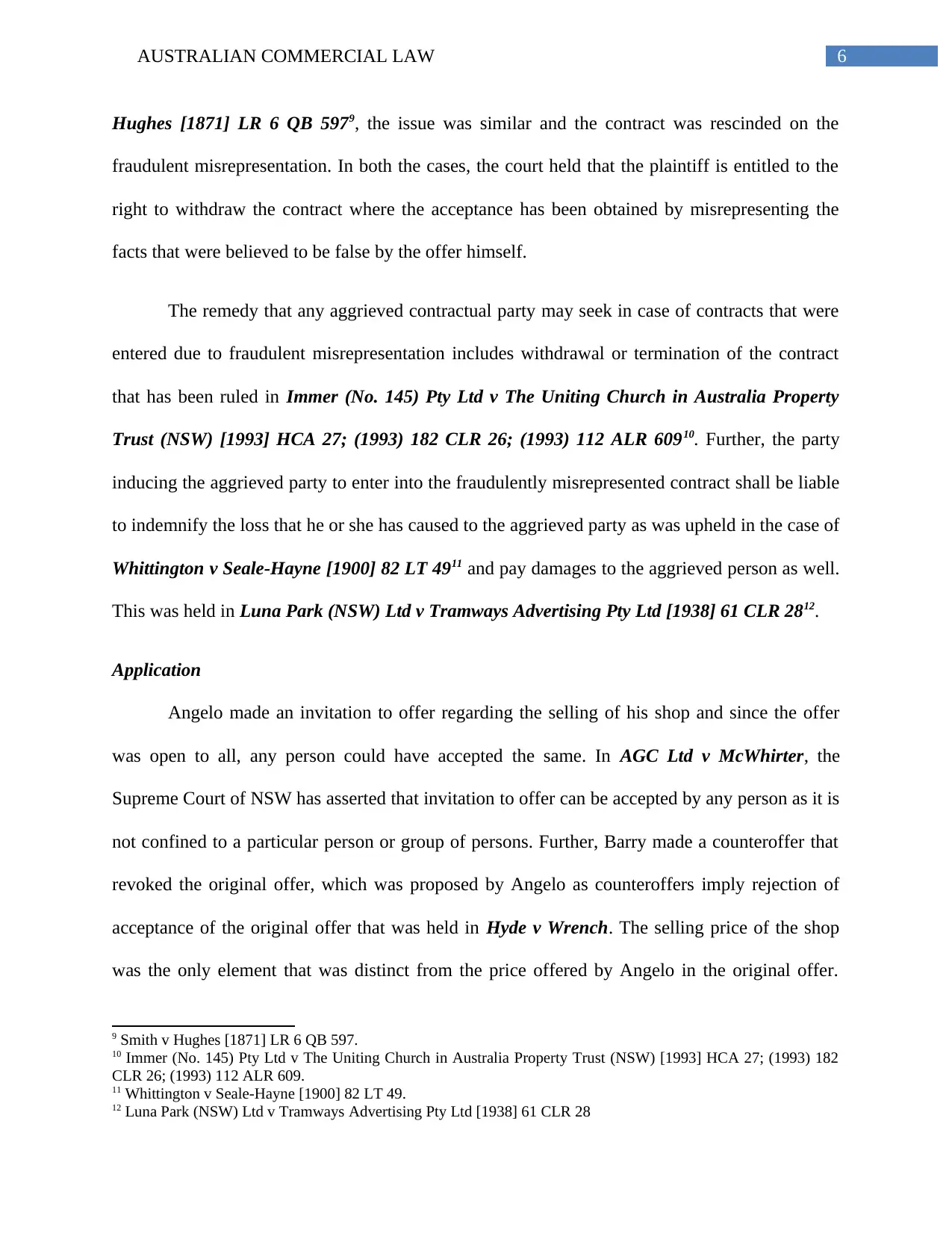
6AUSTRALIAN COMMERCIAL LAW
Hughes [1871] LR 6 QB 5979, the issue was similar and the contract was rescinded on the
fraudulent misrepresentation. In both the cases, the court held that the plaintiff is entitled to the
right to withdraw the contract where the acceptance has been obtained by misrepresenting the
facts that were believed to be false by the offer himself.
The remedy that any aggrieved contractual party may seek in case of contracts that were
entered due to fraudulent misrepresentation includes withdrawal or termination of the contract
that has been ruled in Immer (No. 145) Pty Ltd v The Uniting Church in Australia Property
Trust (NSW) [1993] HCA 27; (1993) 182 CLR 26; (1993) 112 ALR 60910. Further, the party
inducing the aggrieved party to enter into the fraudulently misrepresented contract shall be liable
to indemnify the loss that he or she has caused to the aggrieved party as was upheld in the case of
Whittington v Seale-Hayne [1900] 82 LT 4911 and pay damages to the aggrieved person as well.
This was held in Luna Park (NSW) Ltd v Tramways Advertising Pty Ltd [1938] 61 CLR 2812.
Application
Angelo made an invitation to offer regarding the selling of his shop and since the offer
was open to all, any person could have accepted the same. In AGC Ltd v McWhirter, the
Supreme Court of NSW has asserted that invitation to offer can be accepted by any person as it is
not confined to a particular person or group of persons. Further, Barry made a counteroffer that
revoked the original offer, which was proposed by Angelo as counteroffers imply rejection of
acceptance of the original offer that was held in Hyde v Wrench. The selling price of the shop
was the only element that was distinct from the price offered by Angelo in the original offer.
9 Smith v Hughes [1871] LR 6 QB 597.
10 Immer (No. 145) Pty Ltd v The Uniting Church in Australia Property Trust (NSW) [1993] HCA 27; (1993) 182
CLR 26; (1993) 112 ALR 609.
11 Whittington v Seale-Hayne [1900] 82 LT 49.
12 Luna Park (NSW) Ltd v Tramways Advertising Pty Ltd [1938] 61 CLR 28
Hughes [1871] LR 6 QB 5979, the issue was similar and the contract was rescinded on the
fraudulent misrepresentation. In both the cases, the court held that the plaintiff is entitled to the
right to withdraw the contract where the acceptance has been obtained by misrepresenting the
facts that were believed to be false by the offer himself.
The remedy that any aggrieved contractual party may seek in case of contracts that were
entered due to fraudulent misrepresentation includes withdrawal or termination of the contract
that has been ruled in Immer (No. 145) Pty Ltd v The Uniting Church in Australia Property
Trust (NSW) [1993] HCA 27; (1993) 182 CLR 26; (1993) 112 ALR 60910. Further, the party
inducing the aggrieved party to enter into the fraudulently misrepresented contract shall be liable
to indemnify the loss that he or she has caused to the aggrieved party as was upheld in the case of
Whittington v Seale-Hayne [1900] 82 LT 4911 and pay damages to the aggrieved person as well.
This was held in Luna Park (NSW) Ltd v Tramways Advertising Pty Ltd [1938] 61 CLR 2812.
Application
Angelo made an invitation to offer regarding the selling of his shop and since the offer
was open to all, any person could have accepted the same. In AGC Ltd v McWhirter, the
Supreme Court of NSW has asserted that invitation to offer can be accepted by any person as it is
not confined to a particular person or group of persons. Further, Barry made a counteroffer that
revoked the original offer, which was proposed by Angelo as counteroffers imply rejection of
acceptance of the original offer that was held in Hyde v Wrench. The selling price of the shop
was the only element that was distinct from the price offered by Angelo in the original offer.
9 Smith v Hughes [1871] LR 6 QB 597.
10 Immer (No. 145) Pty Ltd v The Uniting Church in Australia Property Trust (NSW) [1993] HCA 27; (1993) 182
CLR 26; (1993) 112 ALR 609.
11 Whittington v Seale-Hayne [1900] 82 LT 49.
12 Luna Park (NSW) Ltd v Tramways Advertising Pty Ltd [1938] 61 CLR 28
Paraphrase This Document
Need a fresh take? Get an instant paraphrase of this document with our AI Paraphraser
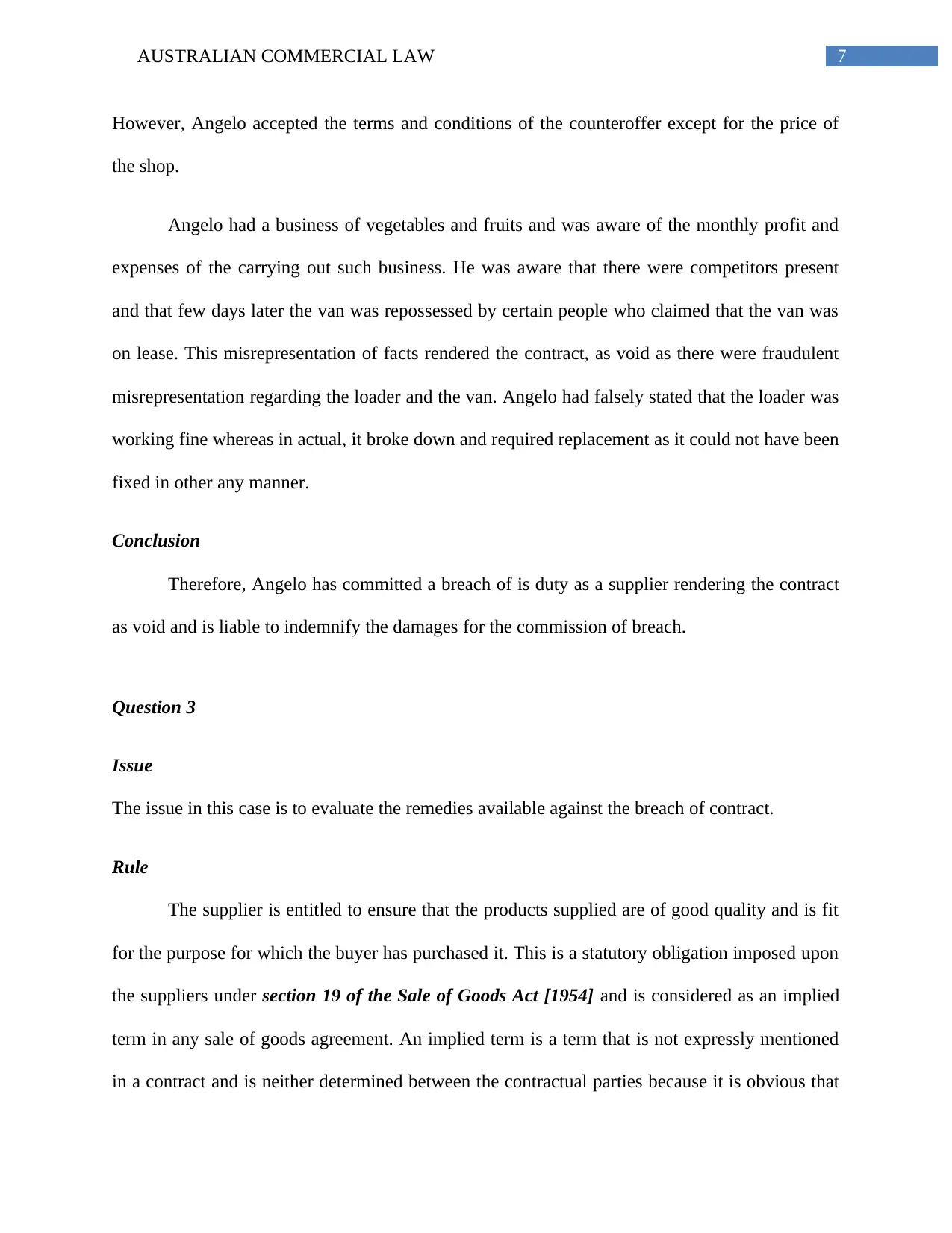
7AUSTRALIAN COMMERCIAL LAW
However, Angelo accepted the terms and conditions of the counteroffer except for the price of
the shop.
Angelo had a business of vegetables and fruits and was aware of the monthly profit and
expenses of the carrying out such business. He was aware that there were competitors present
and that few days later the van was repossessed by certain people who claimed that the van was
on lease. This misrepresentation of facts rendered the contract, as void as there were fraudulent
misrepresentation regarding the loader and the van. Angelo had falsely stated that the loader was
working fine whereas in actual, it broke down and required replacement as it could not have been
fixed in other any manner.
Conclusion
Therefore, Angelo has committed a breach of is duty as a supplier rendering the contract
as void and is liable to indemnify the damages for the commission of breach.
Question 3
Issue
The issue in this case is to evaluate the remedies available against the breach of contract.
Rule
The supplier is entitled to ensure that the products supplied are of good quality and is fit
for the purpose for which the buyer has purchased it. This is a statutory obligation imposed upon
the suppliers under section 19 of the Sale of Goods Act [1954] and is considered as an implied
term in any sale of goods agreement. An implied term is a term that is not expressly mentioned
in a contract and is neither determined between the contractual parties because it is obvious that
However, Angelo accepted the terms and conditions of the counteroffer except for the price of
the shop.
Angelo had a business of vegetables and fruits and was aware of the monthly profit and
expenses of the carrying out such business. He was aware that there were competitors present
and that few days later the van was repossessed by certain people who claimed that the van was
on lease. This misrepresentation of facts rendered the contract, as void as there were fraudulent
misrepresentation regarding the loader and the van. Angelo had falsely stated that the loader was
working fine whereas in actual, it broke down and required replacement as it could not have been
fixed in other any manner.
Conclusion
Therefore, Angelo has committed a breach of is duty as a supplier rendering the contract
as void and is liable to indemnify the damages for the commission of breach.
Question 3
Issue
The issue in this case is to evaluate the remedies available against the breach of contract.
Rule
The supplier is entitled to ensure that the products supplied are of good quality and is fit
for the purpose for which the buyer has purchased it. This is a statutory obligation imposed upon
the suppliers under section 19 of the Sale of Goods Act [1954] and is considered as an implied
term in any sale of goods agreement. An implied term is a term that is not expressly mentioned
in a contract and is neither determined between the contractual parties because it is obvious that
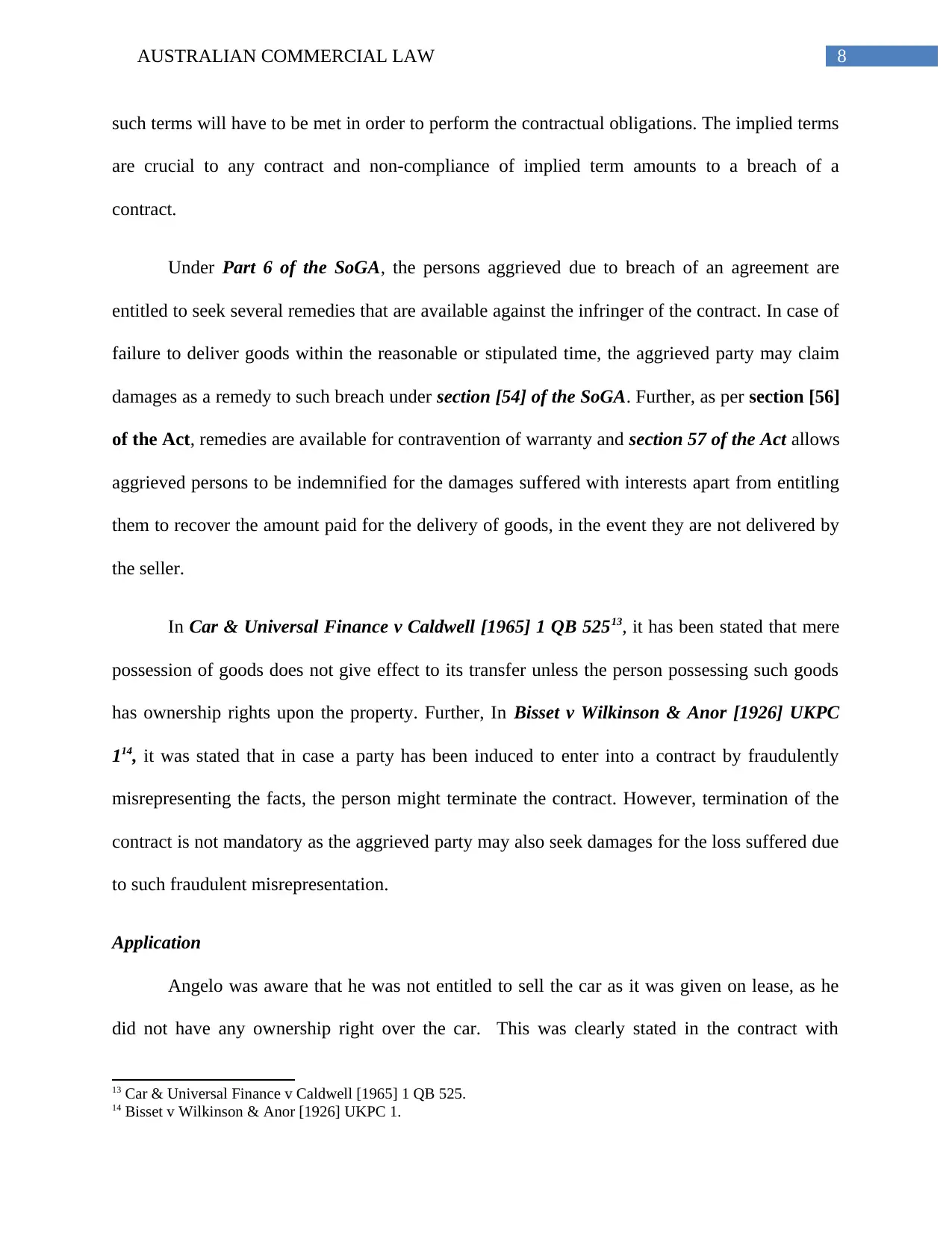
8AUSTRALIAN COMMERCIAL LAW
such terms will have to be met in order to perform the contractual obligations. The implied terms
are crucial to any contract and non-compliance of implied term amounts to a breach of a
contract.
Under Part 6 of the SoGA, the persons aggrieved due to breach of an agreement are
entitled to seek several remedies that are available against the infringer of the contract. In case of
failure to deliver goods within the reasonable or stipulated time, the aggrieved party may claim
damages as a remedy to such breach under section [54] of the SoGA. Further, as per section [56]
of the Act, remedies are available for contravention of warranty and section 57 of the Act allows
aggrieved persons to be indemnified for the damages suffered with interests apart from entitling
them to recover the amount paid for the delivery of goods, in the event they are not delivered by
the seller.
In Car & Universal Finance v Caldwell [1965] 1 QB 52513, it has been stated that mere
possession of goods does not give effect to its transfer unless the person possessing such goods
has ownership rights upon the property. Further, In Bisset v Wilkinson & Anor [1926] UKPC
114, it was stated that in case a party has been induced to enter into a contract by fraudulently
misrepresenting the facts, the person might terminate the contract. However, termination of the
contract is not mandatory as the aggrieved party may also seek damages for the loss suffered due
to such fraudulent misrepresentation.
Application
Angelo was aware that he was not entitled to sell the car as it was given on lease, as he
did not have any ownership right over the car. This was clearly stated in the contract with
13 Car & Universal Finance v Caldwell [1965] 1 QB 525.
14 Bisset v Wilkinson & Anor [1926] UKPC 1.
such terms will have to be met in order to perform the contractual obligations. The implied terms
are crucial to any contract and non-compliance of implied term amounts to a breach of a
contract.
Under Part 6 of the SoGA, the persons aggrieved due to breach of an agreement are
entitled to seek several remedies that are available against the infringer of the contract. In case of
failure to deliver goods within the reasonable or stipulated time, the aggrieved party may claim
damages as a remedy to such breach under section [54] of the SoGA. Further, as per section [56]
of the Act, remedies are available for contravention of warranty and section 57 of the Act allows
aggrieved persons to be indemnified for the damages suffered with interests apart from entitling
them to recover the amount paid for the delivery of goods, in the event they are not delivered by
the seller.
In Car & Universal Finance v Caldwell [1965] 1 QB 52513, it has been stated that mere
possession of goods does not give effect to its transfer unless the person possessing such goods
has ownership rights upon the property. Further, In Bisset v Wilkinson & Anor [1926] UKPC
114, it was stated that in case a party has been induced to enter into a contract by fraudulently
misrepresenting the facts, the person might terminate the contract. However, termination of the
contract is not mandatory as the aggrieved party may also seek damages for the loss suffered due
to such fraudulent misrepresentation.
Application
Angelo was aware that he was not entitled to sell the car as it was given on lease, as he
did not have any ownership right over the car. This was clearly stated in the contract with
13 Car & Universal Finance v Caldwell [1965] 1 QB 525.
14 Bisset v Wilkinson & Anor [1926] UKPC 1.
⊘ This is a preview!⊘
Do you want full access?
Subscribe today to unlock all pages.

Trusted by 1+ million students worldwide
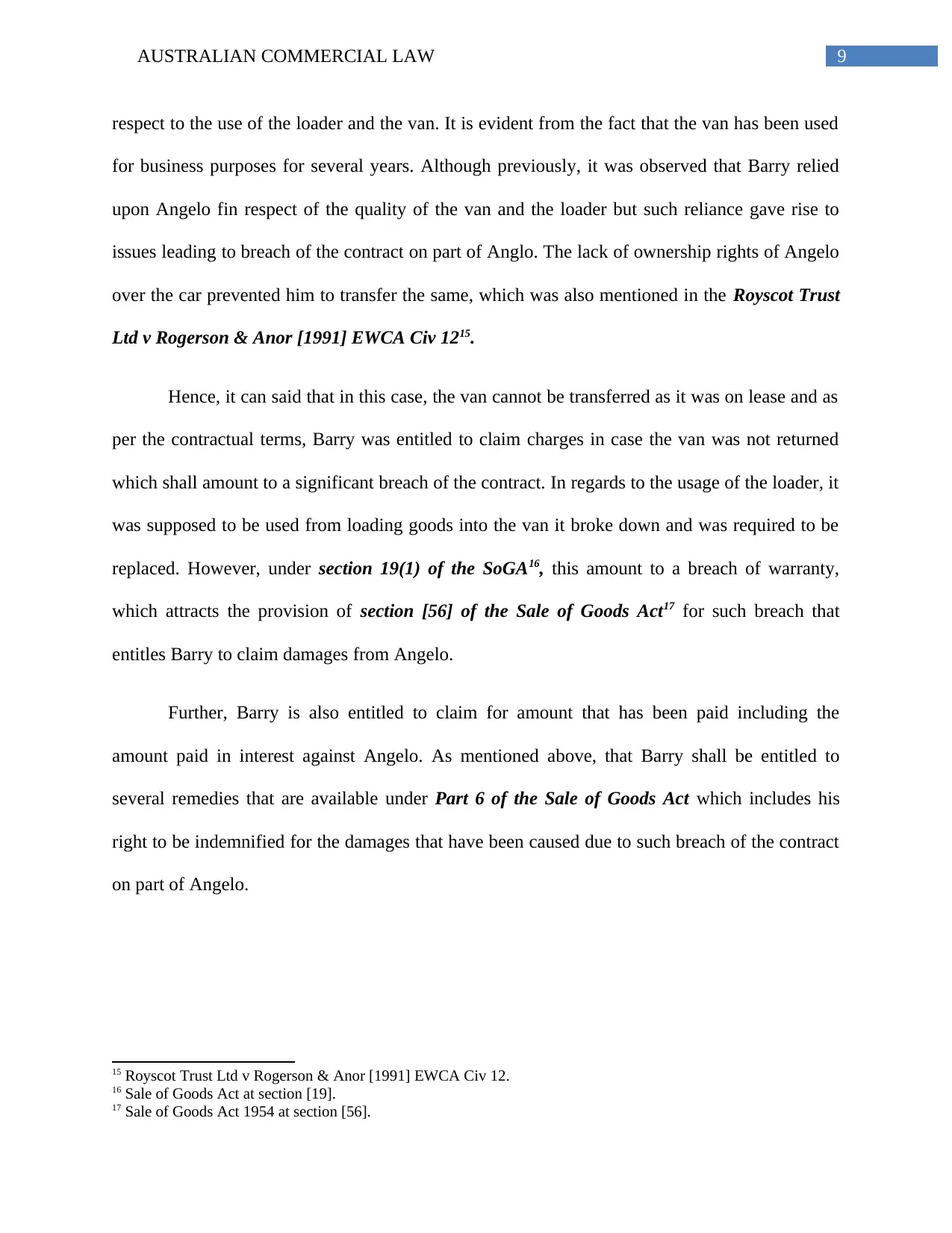
9AUSTRALIAN COMMERCIAL LAW
respect to the use of the loader and the van. It is evident from the fact that the van has been used
for business purposes for several years. Although previously, it was observed that Barry relied
upon Angelo fin respect of the quality of the van and the loader but such reliance gave rise to
issues leading to breach of the contract on part of Anglo. The lack of ownership rights of Angelo
over the car prevented him to transfer the same, which was also mentioned in the Royscot Trust
Ltd v Rogerson & Anor [1991] EWCA Civ 1215.
Hence, it can said that in this case, the van cannot be transferred as it was on lease and as
per the contractual terms, Barry was entitled to claim charges in case the van was not returned
which shall amount to a significant breach of the contract. In regards to the usage of the loader, it
was supposed to be used from loading goods into the van it broke down and was required to be
replaced. However, under section 19(1) of the SoGA16, this amount to a breach of warranty,
which attracts the provision of section [56] of the Sale of Goods Act17 for such breach that
entitles Barry to claim damages from Angelo.
Further, Barry is also entitled to claim for amount that has been paid including the
amount paid in interest against Angelo. As mentioned above, that Barry shall be entitled to
several remedies that are available under Part 6 of the Sale of Goods Act which includes his
right to be indemnified for the damages that have been caused due to such breach of the contract
on part of Angelo.
15 Royscot Trust Ltd v Rogerson & Anor [1991] EWCA Civ 12.
16 Sale of Goods Act at section [19].
17 Sale of Goods Act 1954 at section [56].
respect to the use of the loader and the van. It is evident from the fact that the van has been used
for business purposes for several years. Although previously, it was observed that Barry relied
upon Angelo fin respect of the quality of the van and the loader but such reliance gave rise to
issues leading to breach of the contract on part of Anglo. The lack of ownership rights of Angelo
over the car prevented him to transfer the same, which was also mentioned in the Royscot Trust
Ltd v Rogerson & Anor [1991] EWCA Civ 1215.
Hence, it can said that in this case, the van cannot be transferred as it was on lease and as
per the contractual terms, Barry was entitled to claim charges in case the van was not returned
which shall amount to a significant breach of the contract. In regards to the usage of the loader, it
was supposed to be used from loading goods into the van it broke down and was required to be
replaced. However, under section 19(1) of the SoGA16, this amount to a breach of warranty,
which attracts the provision of section [56] of the Sale of Goods Act17 for such breach that
entitles Barry to claim damages from Angelo.
Further, Barry is also entitled to claim for amount that has been paid including the
amount paid in interest against Angelo. As mentioned above, that Barry shall be entitled to
several remedies that are available under Part 6 of the Sale of Goods Act which includes his
right to be indemnified for the damages that have been caused due to such breach of the contract
on part of Angelo.
15 Royscot Trust Ltd v Rogerson & Anor [1991] EWCA Civ 12.
16 Sale of Goods Act at section [19].
17 Sale of Goods Act 1954 at section [56].
Paraphrase This Document
Need a fresh take? Get an instant paraphrase of this document with our AI Paraphraser
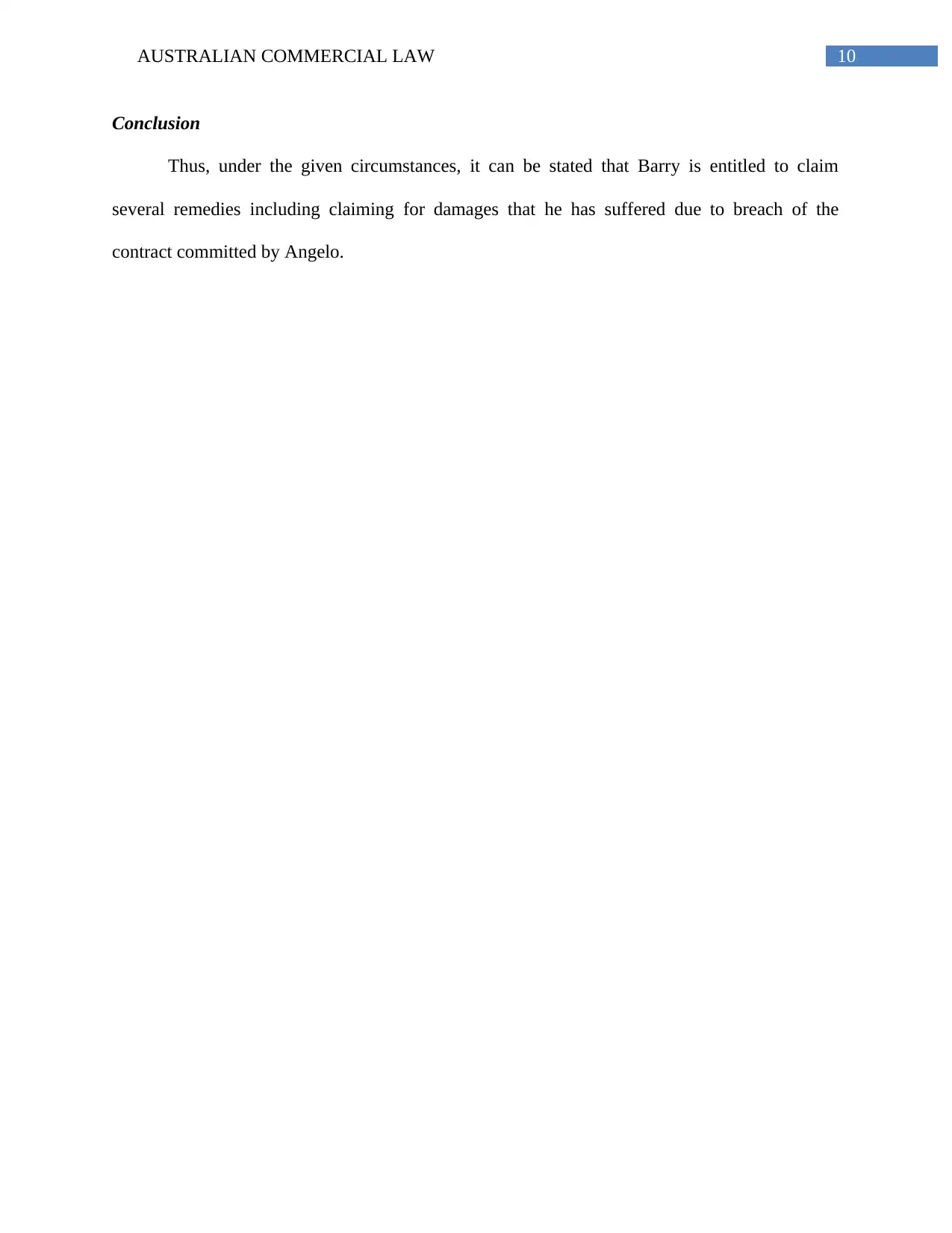
10AUSTRALIAN COMMERCIAL LAW
Conclusion
Thus, under the given circumstances, it can be stated that Barry is entitled to claim
several remedies including claiming for damages that he has suffered due to breach of the
contract committed by Angelo.
Conclusion
Thus, under the given circumstances, it can be stated that Barry is entitled to claim
several remedies including claiming for damages that he has suffered due to breach of the
contract committed by Angelo.
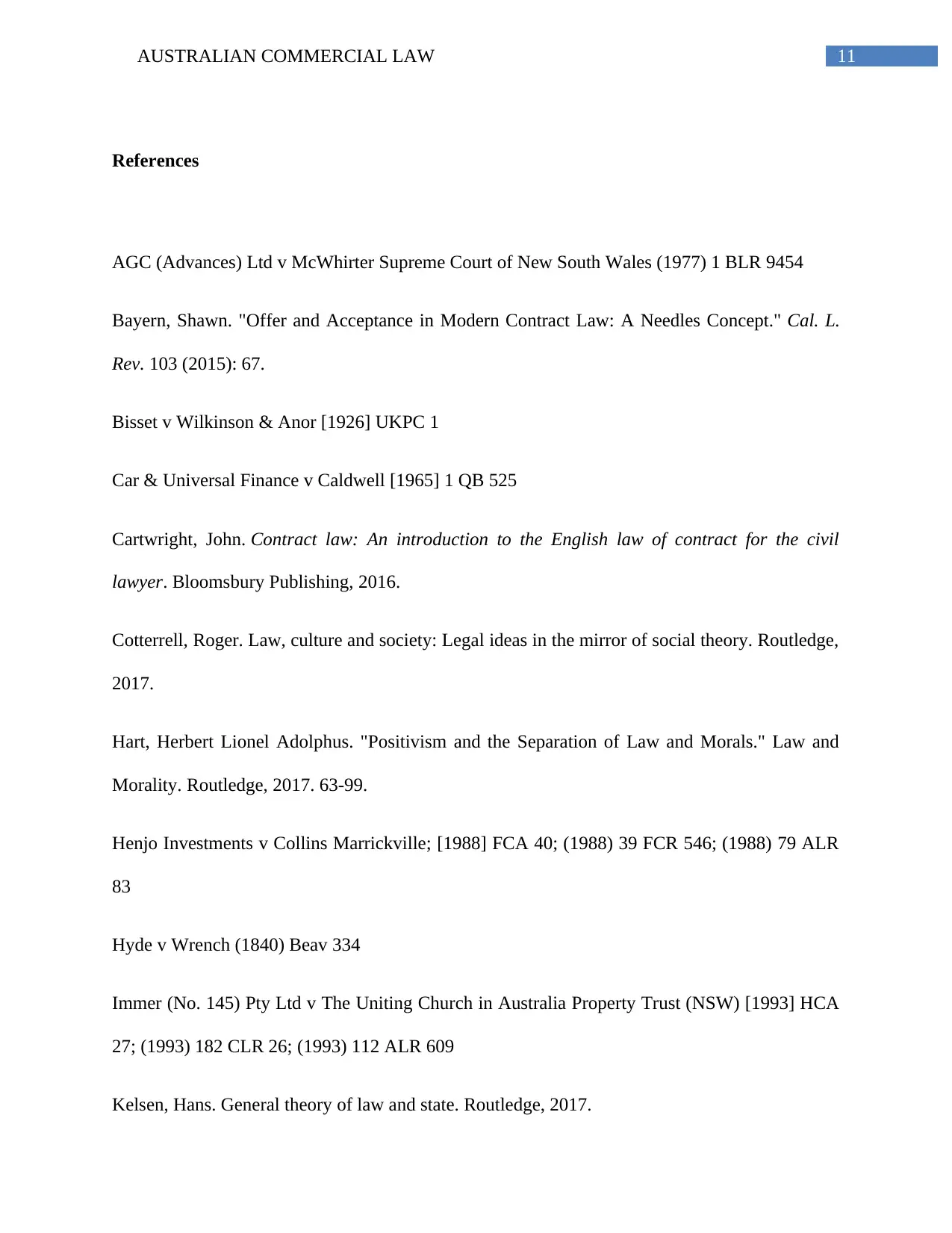
11AUSTRALIAN COMMERCIAL LAW
References
AGC (Advances) Ltd v McWhirter Supreme Court of New South Wales (1977) 1 BLR 9454
Bayern, Shawn. "Offer and Acceptance in Modern Contract Law: A Needles Concept." Cal. L.
Rev. 103 (2015): 67.
Bisset v Wilkinson & Anor [1926] UKPC 1
Car & Universal Finance v Caldwell [1965] 1 QB 525
Cartwright, John. Contract law: An introduction to the English law of contract for the civil
lawyer. Bloomsbury Publishing, 2016.
Cotterrell, Roger. Law, culture and society: Legal ideas in the mirror of social theory. Routledge,
2017.
Hart, Herbert Lionel Adolphus. "Positivism and the Separation of Law and Morals." Law and
Morality. Routledge, 2017. 63-99.
Henjo Investments v Collins Marrickville; [1988] FCA 40; (1988) 39 FCR 546; (1988) 79 ALR
83
Hyde v Wrench (1840) Beav 334
Immer (No. 145) Pty Ltd v The Uniting Church in Australia Property Trust (NSW) [1993] HCA
27; (1993) 182 CLR 26; (1993) 112 ALR 609
Kelsen, Hans. General theory of law and state. Routledge, 2017.
References
AGC (Advances) Ltd v McWhirter Supreme Court of New South Wales (1977) 1 BLR 9454
Bayern, Shawn. "Offer and Acceptance in Modern Contract Law: A Needles Concept." Cal. L.
Rev. 103 (2015): 67.
Bisset v Wilkinson & Anor [1926] UKPC 1
Car & Universal Finance v Caldwell [1965] 1 QB 525
Cartwright, John. Contract law: An introduction to the English law of contract for the civil
lawyer. Bloomsbury Publishing, 2016.
Cotterrell, Roger. Law, culture and society: Legal ideas in the mirror of social theory. Routledge,
2017.
Hart, Herbert Lionel Adolphus. "Positivism and the Separation of Law and Morals." Law and
Morality. Routledge, 2017. 63-99.
Henjo Investments v Collins Marrickville; [1988] FCA 40; (1988) 39 FCR 546; (1988) 79 ALR
83
Hyde v Wrench (1840) Beav 334
Immer (No. 145) Pty Ltd v The Uniting Church in Australia Property Trust (NSW) [1993] HCA
27; (1993) 182 CLR 26; (1993) 112 ALR 609
Kelsen, Hans. General theory of law and state. Routledge, 2017.
⊘ This is a preview!⊘
Do you want full access?
Subscribe today to unlock all pages.

Trusted by 1+ million students worldwide
1 out of 13
Related Documents
Your All-in-One AI-Powered Toolkit for Academic Success.
+13062052269
info@desklib.com
Available 24*7 on WhatsApp / Email
![[object Object]](/_next/static/media/star-bottom.7253800d.svg)
Unlock your academic potential
Copyright © 2020–2025 A2Z Services. All Rights Reserved. Developed and managed by ZUCOL.





